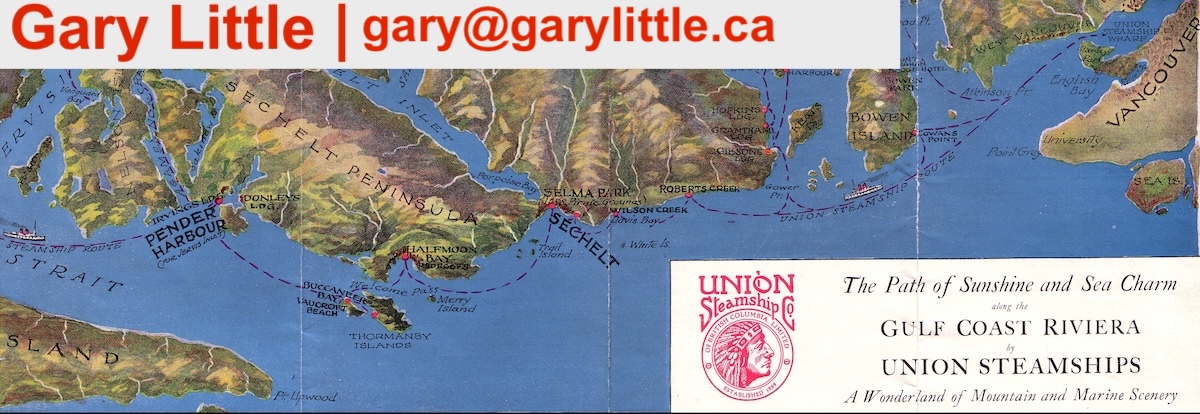Sechelt, BC V0N 3A0
Canada

|
#201 - 5760 Teredo St
Sechelt, BC V0N 3A0 Canada |

|
|
When Good Google Searches Go Bad
SECHELT, BC, CANADA — May 12, 2011 — In the earliest days of exploration of the North Pacific — one of the last navigable areas of the world to be explored — mapmaking errors were commonplace. Latitude readings were difficult when taken from a rolling ship deck and longitude calculations at sea were virtually impossible until James Harrison perfected the marine chronometer in the late 18th century. Mapmakers were also a creative lot who liked to fill in gaps on the map with features based on educated — and often very uneducated — guesses. They were also not averse to making deliberate errors to please their Royal benefactors. As a result, early maps of the area are quite distorted and odd looking to the modern eye, and this is what makes them very desirable and collectible today. Some of the unusual features that can be seen are the island of California, an inland Sea of the West in western Canada about the size of British Columbia, and the Strait of Anian — the northwest passage back to Europe that never was. This made for great entertainment for armchair adventurers back in England, but was frustrating and often dangerous for later explorers relying on these maps for navigation. Nowadays, with high-resolution aerial photography and GPS we expect near perfection in our maps. Alas, serious problems still crop up from time to time, often the result of mapmakers moving too quickly and too recklessly in an attempt to remain one step ahead of the competition. As a result, the modern traveler, relying on these state-of-the-art maps, might sometimes be thrown for unexpected loops almost as surprising as those faced by early 18th century explorers. Today, most people go to the internet when they need to find the map of an area. The most popular of these maps is provided by Google, the Mountain View, Calif. behemoth that makes many boatloads of money every year selling online advertising. But the Google map, despite its popularity, has flaws that can wreak economic misery on affected communities. The town of Sechelt on BC's Sunshine Coast is one of Google's victims. Since early 2010, when Google switched to a new geographic database, it has inadvertently placed the name label for Sechelt about 80 km north of its actual location in a ghost town called, appropriately enough, Deserted Bay. As a result of this poor placement, Google searches for Sechelt often result in information for Whistler being shown because it happens to be the nearest big town to this erroneous location for Sechelt. Never mind that it actually takes about 4 hours (including a ferry trip) to get to the Whistler ski slopes from the Sunshine Coast. This is all very annoying for Sechelt community leaders and it illustrates clearly the problems that can occur when one company has too much power and too little incentive to right wrongs. Google has been notified of this problem many times by local residents. Even Darren Inkster, the Mayor of Sechelt, has weighed in with a letter sent months ago to the head of Google Canada. Google, to its credit, has fixed dozens of incorrect street names on the Sunshine Coast in the past year. But, inexplicably, it seems incapable of placing the town label in the correct place. It's not as if Google is unable to act quickly to solve problems when politically expedient. After the 2010 earthquake in Haiti and the 2011 tsunami in Japan, for example, Google updated its aerial imagery within days. And a misplaced border on a street map of Central America that nearly led to a military skirmish between Nicaragua and Costa Rica was also fixed up lickety-split. "This mapping glitch may seem trivial to some but it has a serious impact on local businesses — a Google search is the way most people begin their trip planning," says Celia Robben, President of Sunshine Coast Tourism. "All we can do is pray that Google fixes this problem promptly." If prayer doesn't work, there's always Hope. It turns out that Hope (BC) was also misplaced on the Google map for several months but this error has now been corrected. Sechelt, though, has not been so fortunate — what is likely needed to trigger a quick fix is a monumental border dispute with the Americans, perhaps "54-40 or Fight", the rematch. ------ Gary Little is in the real estate business at an unlabeled location along BC's Sunshine Coast.
Update: On May 18, 2011, after a delay of almost one year, Google finally fixed the problems discussed in this article. The town label for Sechelt now appears in the correct position and the erroneous labels have been removed.
___________ Gary Little is an innovative real estate agent in the offices of Royal LePage Sunshine Coast in Sechelt, British Columbia. He is well known for his use of technology to provide compelling real estate tools for the general public, notably his interactive real estate map of the Sunshine Coast (first published in 2006), his real estate statistics service, and his real estate services for mobile phone users. You can contact him through www.GaryLittle.ca.
CONTACT INFORMATION
Gary Little, realtor® This news release is located online at: http://www.GaryLittle.ca/pr-20110512.html |